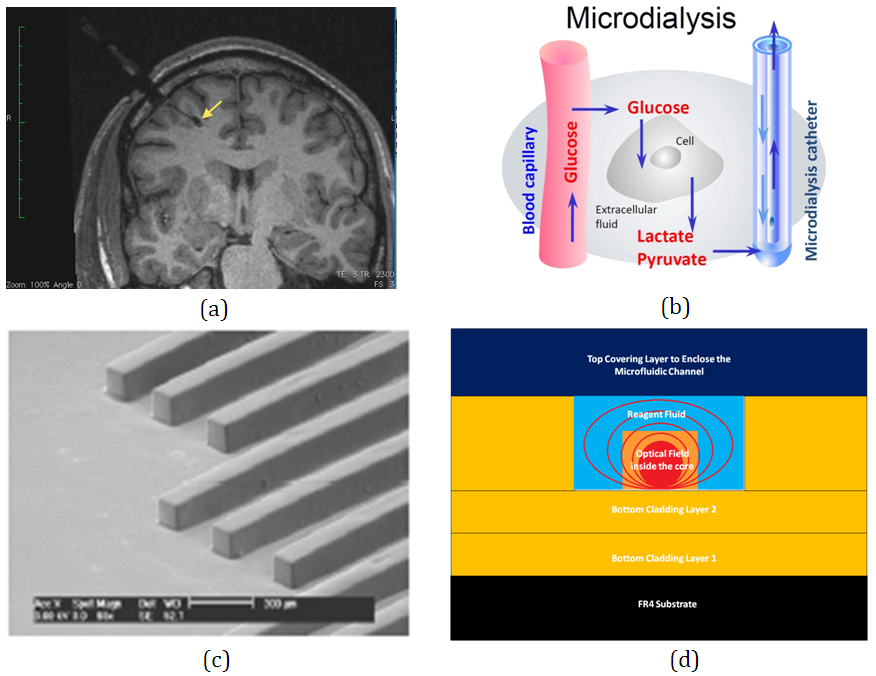Head injury is the leading cause of death in the under-40y population in the developed world. While some individuals have good outcomes, others experience varying degrees of disability, which are often life-long, with consequent demands on carers and resources. Following the initial impact, a complex series of biochemical and biological changes occurs in the hours and days that follow and are potentially amenable to intervention. Brain chemistry, including energy-related molecules, can be monitored by inserting fine semi-permeable tubes into the brain, a technique called microdialysis. A well-recognised characteristic of adverse metabolism is a microdialysate lactate-to-pyruvate ratio of above 25, which is associated with poor outcome. Brain microdialysates are inherently very small volume samples (typically 18 μL/h), and are technologically demanding to analyse. Glucose, lactate and pyruvate are measured at the bedside using commercially available analyzers, but because of these instrumentsí technical limitations, they have a slow response time.
The goal of the proposed project is to enable pilot work on the development of an optical sensor for the continuous real-time measurement of glucose, lactate and pyruvate concentrations in brain microdialysates from head injury patients in the Neurosciences Critical Care Unit (NCCU) at Addenbrooke's Hospital using polymer waveguide technology developed by the Photonic Systems group in the Engineering Department. The work aims at carrying out initial investigations on the potential of developing low-cost bio-medical polymeric optical sensors suitable for use in clinical environments and generating early-stage results to attract further funding towards this goal.

(a) Magnetic resonance image (MRI) showing the brain of a head injury patient with a microdialysis catheter tube in position, the tip indicated by an arrow (yellow). Scale bars (green) show centimetre divisions. (MRI technical details: 3D MPóRAGE sequence, at 3 Tesla). Image is courtesy of the Wolfson Brain Imaging Centre (University of Cambridge). (b) Schematic diagram showing the principles of microdialysis. Blood capillaries supply glucose as a source of energy for the brain cells, which metabolise it. Some of the products (metabolites), including lactate and pyruvate, emerge from the cells into the brainís extracellular fluid and are collected by the microdialysis catheter tube. (c) Scanning electron microscope (SEM) image of polymer waveguides and (d) schematic of the optical sensing principle based on optical absorption.
| Gergely Zsigmond Racz |
Department of Engineering |
| Prof. Richard Penty |
Department of Engineering |
| Dr. Nikos Bamiedakis |
Department of Engineering |
| Mr. Peter Hutchinson |
Department of Clinical Neurosciences |
| Dr. Keri Carpenter |
Department of Clinical Neurosciences |
 (a) Magnetic resonance image (MRI) showing the brain of a head injury patient with a microdialysis catheter tube in position, the tip indicated by an arrow (yellow). Scale bars (green) show centimetre divisions. (MRI technical details: 3D MPóRAGE sequence, at 3 Tesla). Image is courtesy of the Wolfson Brain Imaging Centre (University of Cambridge). (b) Schematic diagram showing the principles of microdialysis. Blood capillaries supply glucose as a source of energy for the brain cells, which metabolise it. Some of the products (metabolites), including lactate and pyruvate, emerge from the cells into the brainís extracellular fluid and are collected by the microdialysis catheter tube. (c) Scanning electron microscope (SEM) image of polymer waveguides and (d) schematic of the optical sensing principle based on optical absorption.
(a) Magnetic resonance image (MRI) showing the brain of a head injury patient with a microdialysis catheter tube in position, the tip indicated by an arrow (yellow). Scale bars (green) show centimetre divisions. (MRI technical details: 3D MPóRAGE sequence, at 3 Tesla). Image is courtesy of the Wolfson Brain Imaging Centre (University of Cambridge). (b) Schematic diagram showing the principles of microdialysis. Blood capillaries supply glucose as a source of energy for the brain cells, which metabolise it. Some of the products (metabolites), including lactate and pyruvate, emerge from the cells into the brainís extracellular fluid and are collected by the microdialysis catheter tube. (c) Scanning electron microscope (SEM) image of polymer waveguides and (d) schematic of the optical sensing principle based on optical absorption.